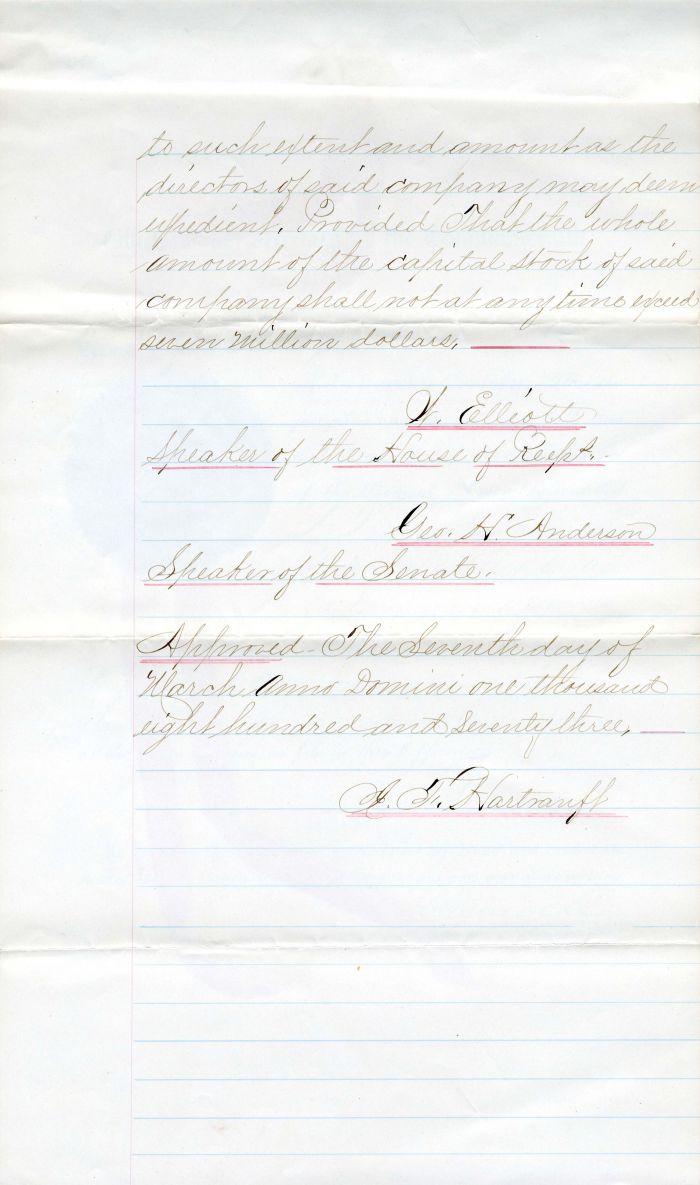Document signed by J.F. Hartranft
Inv# AU1354
4 page Treasury Department of Pennsylvania document signed by J.F. Hartranft

General John Frederick Hartranft (1830-1899) A Union general during the American Civil War, and the governor of Pennsylvania from 1873 to 1879. At the war's end, Hartranft commanded the Old Capitol Prison and was appointed a special provost marshal during the trial of those accused in the Lincoln assassination. He was noted for his kind treatment toward Mary Surratt, the first woman executed by the Federal government. On July 7, 1865, Hartranft led Mary Surratt, Lewis Paine, David Herold and George Atzerodt to the gallows in Fort Lesley McNair. He read them their last rights and they were hanged. Hartranft switched party allegiances following the war and became a Republican, serving in former general John W. Geary's Pennsylvania administration as Auditor General from 1867 to 1873 before being elected governor in 1872. He was a strong advocate of education, municipal reform, regulation of banking, improved industry and commerce, and the reorganization of the National Guard. He supported suffrage for African Americans, fought the corrupt Simon Cameron political machine, and championed the rights of the workingman. During his administration, the revision of the Commonwealth's constitution was completed and ratified as the Constitution of 1873, which prohibited special and local legislation and changed the terms for members of the state legislature to two years instead of one, and state senators from three years to four. He was the 5th commander-in-chief of the Union veterans’ organization, the Grand Army of the Republic, serving from 1875 to 1877. The United States celebrated its centennial as a nation in 1876, and Hartranft saw that Pennsylvania led the way in the celebration that was centered in Philadelphia's Fairmont Park. At the Republican National Convention in June 1876, he was a contender for the presidential nomination that eventually went to Rutherford B. Hayes of Ohio, who had served with Hartranft during the Civil War in the same army corps. During his second term, economic depression and unemployment, following the industrial boom of the early 1870s, caused several serious civil disturbances, including the railroad strikes of 1877 and the incidents with the Molly Maguires in the anthracite coal regions. Hartranft called out the state militia and then Regular Army troops to maintain order. In Philadelphia, Reading, and Pittsburgh, fires burned and eleven people died along the Schuylkill River before Federal troops restored the peace. Hartranft later proposed recognition of labor unions and arbitration of claims. Concerned with the governor's precedent in calling out the militia to battle civilians in Pittsburgh, the District Attorney of Allegheny County tried to force Hartranft to appear before a grand jury to explain his rationale. The courts backed Hartranft when he refused to appear. Their ruling became known as the "Hartranft Decision." Hartranft returned to his home in Montgomery County in 1879, where he accepted the position of Postmaster. He was subsequently appointed Port Collector for Philadelphia. He was also reappointed to command the Pennsylvania National Guard, which he had helped develop.










Ebay ID: labarre_galleries